Enhancing Vietnam’s Nationally Determined Contribution with Mitigation Targets for Agroforestry: A Technical and Economic Estimate
Abstract
1. Introduction
2. Materials and Methods
2.1. Methodological Framework
2.1.1. Step 1: Determine Key Existing Agroforestry Systems in Vietnam
2.1.2. Step 2: Estimate Sequestered Carbon in Existing Areas of Agroforestry
2.1.3. Step 3: Determine Potential Areas for Agroforestry Expansion
2.1.4. Step 4: Select Agroforestry Systems for Expansion and Land Suitability Analysis
2.1.5. Step 5: Estimate Sequestered Carbon in Potential Expansion Areas
2.1.6. Step 6: Estimate the Cost Efficiency of Agroforestry Expansion
3. Results
3.1. Sequestered Carbon in Existing Areas of Agroforestry
3.2. Suitable Areas for Agroforestry Expansion
3.3. Sequestered Carbon in the Agroforestry Expansion Areas
3.4. Cost Efficiency of Agroforestry Expansion
3.5. Mitigation Contribution to Agriculture Sector
4. Discussion
4.1. Agroforestry in Vietnam’s 2020 NDCs
4.2. Agroforestry Systems for Expansion and Impact of Climate Change
4.3. Advantages of Using Agroforestry Rather than Sole Crop Plantation for NDCs
4.4. Caveats in the Carbon and Cost Assessment for Agroforestry
4.5. Ways Forward to Foster Agroforestry in Vietnam’s NDC
5. Conclusions
Author Contributions
Funding
Acknowledgments
Conflicts of Interest
Appendix A
| Agroforestry System | Tree Density (trees ha−1) * | AGC ** | BGC | SOC *** | Source |
|---|---|---|---|---|---|
| Tea-based | Agroforestry (AF): 17,000 (tea), 150–200 (shade trees) Sole: 18,000–25,000 | TA: 13.3 tC ha−1 SR AF: 1.7 ± 0.18 tC ha−1 year−1 SR sole: 1.4 ± 0.14 tC ha−1 year−1 | BGC/AGC: 0.10–0.34 | RR-TA: 1.0 ± 0.2 SR: 1.59 ± 0.4 tC ha−1 year−1 | AGC-TA and AGC-SR AF: [60] for the case in North East Vietnam. AGC-SR sole: calculated from [61]. BGC/AGC for AF [14]. RR-TA from ‘forest to shade perennial’ for tropical region [10]. SOC-SR from ‘croplands to multistrata system’ for tropical region [10] |
| Coffee robusta-based | AF: 500–1100 (coffee), 85–150 (shade trees) Sole: 750–1500 | TA: 13.4 ± 0.3 tC ha−1 SR AF: 2.63 ± 0.55 tC ha−1 year−1 SR sole: 0.75 ± 0.01 tC ha−1 year−1 | BGC/AGC: 0.10–0.34 | RR-TA: 1.0 ± 0.2 SR: 1.59 ± 0.4 tC ha−1 year−1 | AGC-TA [50]. AGC-SR AF: calculated from [62]. AGC-SR sole and calculated using allometric equation from [63]. All for the case in Central Highlands. BGC/AGC for AF [14]. RR-TA and SOC-SR similar as for tea. |
| Coffee arabica-based | AF: 3000–5000 (coffee), 100–200 (shade trees) Sole: 4000–8000 | TA: 13.5 ± 5.5 tC ha−1 SR AF: 1.9 ± 0.24 tC ha−1 year−1 SR sole: 0.5 ± 0.06 tC ha−1 year−1 | BGC/AGC: 0.10–0.34 | RR-TA: 1.0 ± 0.2 SR: 1.59 ± 0.4 tC ha−1 year−1 | AGC-TA and AGC-SR AF: [64] for the case in North West. AGC-SR sole: calculated using allometric equation from [65] for the case in North West. RR-TA and SOC-SR similar as for robusta. |
| Cashew-based | 100–200 | TA: 54.2 tC ha−1 SR: 4.2 ± 0.35 tC ha−1 year−1 | TA: 9.2 tC ha−1 SR: 0.7 ± 0.06 tC ha−1 year−1 | RR-TA: 0.95 SR: 0.84 ± 0.26 tC ha−1 year−1 | AGC-TA, AGC-SR, BGC-TA, BGC-SR: stem diameter from [66] and allometry equation from [67]. RR-TA from forest to silvoarable for tropical region [10]. SOC-SR from ‘croplands to silvoarable’ for tropical region [10]. |
| Rubber-based | 500 | TA: 25.3 ± 2.76 tC ha−1 | TA: 4.5 ± 0.3 tC ha−1 | RR-TA: 0.95 | AGC-TA: stem diameter [68], allometric equation: [69]. BGC-TA: using AGC-BGC relation from [69]. RR-TA is similar as for cashew [10] |
| Acacia spp.-based # | Short-rotation (3–5 years): 4500–8000 Long-rotation (8–12 years): 600–1200 | TA: 25.3 ± 6.2 tC ha−1 SR: 4.0 ± 0.37 tC ha−1 year−1 | BGC/AGC: 0.10–0.33 | RR-TA: 0.95 SR: 0.84 ± 0.26 tC ha−1 year−1 | AGC-TA and AGC-SR: [26] for the case in South Central Coast. BGC/AGC for tree plantation [14]. RR-TA is similar as for rubber [10]. SOC-SR similar as for cashew. |
| Rhizophora-based | 8000–10,000 | TA: 156.4 tC ha−1 | TA: 568.4 tC ha−1 | TA: 386 tC ha−1 | AGC-TA and BGC-TA calculated based on [70] for the case in Mekong River Delta. SOC-TA [71] |
| Melaleuca-based | 5500–6500 | TA: 178.4 ± 14.6 tC ha−1 | TA: 44.6 ± 4.3 tC ha−1 | TA: 312.2 ± 25.4 tC ha−1 | AGC-TA, BGC-TA, SOC-TA: calculated based on [72] for the case in Mekong River Delta |
| AGC (mil tCO2e) | BGC (mil tCO2e) | SOC (mil tCO2e) | TOC ** (mil tCO2e) | ||||||
|---|---|---|---|---|---|---|---|---|---|
| Agroforestry System * | Area (103 ha) | Total | SE | Total | SE | Total | SE | Total | SE |
| Melaleuca-based | 246 | 161 | 6.19 | 40 | 1.83 | 281 | 10.8 | 482 | 18.8 |
| Robusta-based | 245 | 12 | 0.12 | 2.4 | 0.57 | 123 | 29.1 | 137 | 29.5 |
| Rhizophora-based | 149 | 86 | 4.04 | 320 | 8.93 | 211 | 9.97 | 617 | 22.4 |
| Acacia-based | 130 | 12 | 1.40 | 2.4 | 0.57 | 62 | 14.6 | 76.1 | 15.6 |
| Rubber-based | 21 | 1.9 | 0.10 | 0.4 | 0.09 | 9.8 | 2.3 | 12.0 | 2.4 |
| Arabica-based | 11 | 0.5 | 0.06 | 0.1 | 0.02 | 5.3 | 1.25 | 5.9 | 1.3 |
| Cashew-based | 10 | 2.1 | 0.10 | 0.4 | 0.03 | 4.9 | 1.17 | 7.4 | 1.25 |
| Tea-based | 10 | 0.5 | 0.04 | 0.1 | 0.02 | 4.8 | 1.13 | 5.4 | 1.17 |
| All systems | 820 | 275 | 12.0 | 366 | 12.1 | 701 | 70.4 | 1343 | 92.4 |
| Acacia | Arabica | Robusta | Cashew | Tea | |||||||||||
|---|---|---|---|---|---|---|---|---|---|---|---|---|---|---|---|
| ER * | Baseline | RCP 4.5 | RCP 8.5 | Baseline | RCP 4.5 | RCP 8.5 | Baseline | RCP 4.5 | RCP 8.5 | Baseline | RCP 4.5 | RCP 8.5 | Baseline | RCP 4.5 | RCP 8.5 |
| Highly suitable area (thousand ha) | |||||||||||||||
| NW | 12 | 22 | 23 | 19 | 6 | 3 | 11 | 8 | 6 | 0.01 | 4 | 8 | 6 | ||
| NE | 94 | 112 | 109 | 13 | 3 | 1 | 81 | 9 | 5 | 0.01 | 0.01 | 0.01 | 13 | 38 | 32 |
| RRD | 41 | 42 | 42 | 23 | 0.01 | 8 | 1 | ||||||||
| NCC | 42 | 55 | 47 | 0.01 | 3 | 0.01 | 0.01 | 0.01 | 12 | 1 | 1 | ||||
| SCC | 2 | 0.01 | 1 | 0.01 | 0.01 | 0.01 | 0.01 | 0.01 | 0.01 | 0.01 | 0.01 | 0.01 | |||
| CH | 192 | 202 | 166 | 23 | 6 | 2 | 72 | 19 | 21 | 23 | 20 | 16 | 150 | 114 | 86 |
| SE | 35 | 1 | 1 | 0.01 | 0.01 | 0.01 | 1 | 0.01 | 2 | 0.01 | |||||
| MRD | 0.01 | ||||||||||||||
| Total | 419 | 435 | 389 | 54 | 15 | 6 | 189 | 36 | 32 | 24 | 21 | 17 | 181 | 170 | 127 |
| Combined (highly and less) suitable area (thousand ha) | |||||||||||||||
| NW | 282 | 307 | 309 | 190 | 141 | 120 | 210 | 210 | 210 | 236 | 236 | 236 | 194 | 194 | 194 |
| NE | 472 | 491 | 493 | 342 | 102 | 80 | 411 | 413 | 414 | 369 | 373 | 373 | 345 | 345 | 345 |
| RRD | 72 | 72 | 72 | 39 | 68 | 68 | 68 | 41 | 41 | 41 | 40 | 40 | 40 | ||
| NCC | 250 | 250 | 250 | 66 | 5 | 2 | 232 | 232 | 232 | 175 | 176 | 176 | 173 | 173 | 173 |
| SCC | 99 | 99 | 99 | 1 | 0 | 0 | 82 | 77 | 84 | 48 | 42 | 52 | 69 | 68 | 72 |
| CH | 881 | 884 | 885 | 298 | 114 | 65 | 718 | 718 | 718 | 704 | 679 | 723 | 715 | 715 | 715 |
| SE | 344 | 337 | 353 | 1 | 0 | 0 | 257 | 254 | 263 | 209 | 207 | 218 | 243 | 241 | 251 |
| MRD | 8 | 8 | 8 | 8 | 8 | 8 | 8 | 8 | 8 | 7 | 7 | 7 | |||
| Total | 419 | 435 | 389 | 54 | 15 | 6 | 189 | 36 | 32 | 24 | 21 | 17 | 181 | 170 | 127 |
| Sequestered TOC (mil tCO2e) by 2030 * | |||||||||
|---|---|---|---|---|---|---|---|---|---|
| Highly Suitable | Highly and 10% Less Suitable | Highly and 25% Less Suitable | |||||||
| Scenario ** | Baseline | RCP4.5 | RCP8.5 | Baseline | RCP4.5 | RCP8.5 | Baseline | RCP4.5 | RCP8.5 |
| 1 | 44 ± 4.5 | 46 ± 4.5 | 40 ± 4.1 | 65 ± 7.1 | 67 ± 7.2 | 62 ± 6.6 | 96 ± 11 | 98 ± 11 | 95 ± 11 |
| 2 | 3.2 ± 0.4 | 0.9 ± 0.1 | 0.4 ± 0.1 | 8.3 ± 1.1 | 3.0 ± 0.4 | 1.8 ± 0.2 | 16 ± 2.1 | 6.0 ± 0.8 | 4.0 ± 0.5 |
| 3 | 13 ± 2.1 | 2.5 ± 0.4 | 2.3 ± 0.4 | 26 ± 1.9 | 16 ± 1.8 | 16 ± 1.9 | 45 ± 4.5 | 37 ± 4.4 | 37 ± 4.5 |
| 4 | 2.3 ± 0.2 | 1.9 ± 0.2 | 1.6 ± 0.2 | 19 ± 4.2 | 19 ± 2.5 | 19 ± 2.5 | 45 ± 7.4 | 44 ± 5.7 | 45 ± 5.7 |
| 5 | 9.6 ± 1.2 | 8.9 ± 1.1 | 6.7 ± 0.9 | 18 ± 2.4 | 18 ± 2.3 | 16 ± 2.1 | 31 ± 4.2 | 31 ± 4.1 | 29 ± 3.8 |
References
- UNFCCC. Aggregate Effect of the Intended Nationally Determined Contributions: An Update; UNFCCC: Marrakech, Morocco, 2016. [Google Scholar]
- UNFCCC. Parties. Available online: https://unfccc.int/process/parties-non-party-stakeholders/parties-convention-and-observer-states?field_national_communications_target_id%5B514%5D=514 (accessed on 15 September 2020).
- FAO. The Agriculture Sectors in the Intended Nationally Determined Contribution: Analysis; FAO: Italy, Rome, 2016. [Google Scholar]
- Feliciano, D.; Ledo, A.; Hillier, J.; Nayak, D.R. Which agroforestry options give the greatest soil and above ground carbon benefits in different world regions? Agric. Ecosyst. Environ. 2018, 254, 117–129. [Google Scholar] [CrossRef]
- Zomer, R.J.; Neufeldt, H.; Xu, J.; Ahrends, A.; Bossio, D.; Trabucco, A.; Van Noordwijk, M.; Wang, M. Global tree cover and biomass carbon on agricultural land: The contribution of agroforestry to global and national carbon budgets. Sci. Rep. 2016, 6, 29987. [Google Scholar] [CrossRef] [PubMed]
- Lasco, R.D.; Delfino, R.J.P.; Espaldon, M.L.O. Agroforestry systems: Helping smallholders adapt to climate risks while mitigating climate change. Wiley Interdiscip. Rev. Clim. Chang. 2014, 5, 825–833. [Google Scholar] [CrossRef]
- Catacutan, D.C.; van Noordwijk, M.; Nguyen, T.H.; Öborn, I.; Mercado, A.R. Agroforestry: Contribution to Food Security and Climate-Change Adaptation and Mitigation in Southeast Asia; World Agroforestry Centre (ICRAF) Southeast Asia Regional Program; ASEAN-Swiss Partnership on Social Forestry and Climate Change: Bogor, Indonesia, 2017. [Google Scholar]
- van Noordwijk, M.; Bayala, J.; Hairiah, K.; Lusiana, B.; Muthuri, C.; Khasanah, M.; Mulia, R. Agroforestry solutions for buffering climate variability and adapting to change. In Climate Change Impact and Adaptation in Agricultural Systems; Fuhrer, J., Gregory, P.J., Eds.; CAB International: Wallingford, UK, 2014; pp. 216–232. [Google Scholar]
- Simelton, E.; Dam, B.V.; Catacutan, D. Trees and agroforestry for coping with extreme weather events: Experiences from northern and central Vietnam. Agrofor. Syst. 2015, 89, 1065–1082. [Google Scholar] [CrossRef]
- Cardinael, R.; Umulisa, V.; Toudert, A.; Olivier, A.; Bockel, L.; Bernoux, M. Revisiting IPCC Tier 1 coefficients for soil organic and biomass carbon storage in agroforestry systems. Environ. Res. Lett. 2018, 13, 124020. [Google Scholar] [CrossRef]
- MONRE. The Initial Biennial Updated Report of Vietnam to the United Nations Framework Convention on Climate Change; MONRE: Hanoi, Vietnam, 2014. [Google Scholar]
- Escobar-Carbonari, D.; Grosjean, G.; Läderach, P.; Nghia, T.D.; Sander, B.O.; McKinley, J.; Sebastian, L.; Tapasco, J. Reviewing Vietnam’s Nationally Determined Contribution: A new perspective using the marginal cost of abatement. Front. Sustain. Food Syst. 2019, 3, 14. [Google Scholar] [CrossRef]
- Vu, T.P.; Nguyen, T.M.L.; Nguyen, N.L.; Do, D.S.; Nguyen, X.Q.; Tran, V.L.; Ngo, D.Q.; Tran, V.C.; Nguyen, D.K.; Lai, V.C.; et al. Final Report on Forest Ecological Stratification in Vietnam; Research Centre for Forest Ecology and Environment: Hanoi, Vietnam, 2011. [Google Scholar]
- Ziegler, A.D.; Phelps, J.; Yuen, J.Q.; Webb, E.L.; Lawrence, D.; Fox, J.M.; Bruun, T.B.; Leisz, S.J.; Ryan, C.M.; Dressler, W.; et al. Carbon outcomes of major land-cover transitions in SE Asia: Great uncertainties and REDD+ policy implications. Glob. Chang. Biol. 2012, 18, 3087–3099. [Google Scholar] [CrossRef]
- Saah, D.; Tenneson, K.; Poortinga, A.; Nguyen, Q.; Chishtie, F.; Aung, K.S.; Markert, K.N.; Clinton, N.; Anderson, E.R.; Cutter, P.; et al. Primitives as building blocks for constructing land cover maps. Int. J. Appl. Earth Obs. Geoinf. 2020, 85, 101979. [Google Scholar] [CrossRef]
- Shih, S.S. Spatial habitat suitability models of mangroves with Kandelia obovata. Forests 2020, 11, 477. [Google Scholar] [CrossRef]
- Pistorius, T.; Ho, D.T.H.; Tennigkeit, T.; Merger, E.; Wittmann, N.; Conway, D. Business Models for the Restoration of Short-Rotation Acacia Plantations in Vietnam; UNIQUE Forestry and Land Use GmbH: Hanoi, Vietnam, 2016. [Google Scholar]
- FAO. A Framework for Land Evaluation; Food and Agriculture Organization of the United Nations: Rome, Italy, 1976. [Google Scholar]
- MARD. National Guideline Number TCVN 8409:2010 on Land Evaluation Procedure for Land Use Planning at District Level; MARD: Hanoi, Vietnam, 2010. [Google Scholar]
- Nguyen, V.L. Use of GIS Modelling in Assessment of Foresty Land’s Potential in Thua Thien Hue Province of Central Vietnam; Georg-August-University: Gottingen, Germany, 2008. [Google Scholar]
- VAFS. Determine Appropriate Regional Planting of A. Mangium × A. Auriculiformis for Timber Supply in North Central; VAFS: Hanoi, Vietnam, 2010. [Google Scholar]
- Hijmans, R.J.; Cameron, S.E.; Parra, J.L.; Jones, P.G.; Jarvis, A. Very high resolution interpolated climate surfaces for global land areas. Int. J. Climatol. 2005, 25, 1965–1978. [Google Scholar] [CrossRef]
- IPCC-TGCIA. General Guidelines on the Use of Scenario Data for Climate Impact and Adaptation Assessment; Finnish Environment Institute: Helsinki, Finland, 2007. [Google Scholar]
- Kamworapan, S.; Surussavadee, C. Performance of CMIP5 global climate models for climate simulation in Southeast Asia. In Proceedings of the IEEE Region 10 Annual International Conference, Proceedings/TENCON, Penang, Malaysia, 5–8 November 2017; pp. 718–722. [Google Scholar]
- Saah, D.; Battles, J.; Gunn, J.; Buchholz, T.; Schmidt, D.; Roller, G.; Romsos, S. Technical Improvements to the Greenhouse Gas (GHG) Inventory for California Forests and Other Lands; Spatial Informatics Group: Pleasanton, CA, USA, 2015. [Google Scholar]
- Mulia, R.; Khasanah, N.; Catacutan, D.C. Alternative forest plantation systems for Southcentral Coast of Vietnam: Projections of growth and production using the WaNuLCAS model. In Towards Low-Emission Landscapes in Vietnam; Mulia, R., Simelton, E., Eds.; World Agroforestry (ICRAF) Vietnam, World Agroforestry (ICRAF) Southeast Asia Regional Program: Hanoi, Vietnam, 2018; pp. 45–60. [Google Scholar]
- Kuit, M.; Jansen, D.M.; Nguyen, V.T. Manual for Arabica Cultivation; Tan Lam Agricultural Product Joint Stock Company: Quang Tri, Vietnam, 2004. [Google Scholar]
- Catacutan, D.C.; Huy, B.; Pham, T.V.; Mulia, R. Gender, Land Use and Land Use Change in Vietnam: Coffee as Commodity Driver of Land Use Change in the Central Highlands of Vietnam; World Agroforestry (ICRAF): Hanoi, Vietnam, 2015. [Google Scholar]
- Mulia, R.; Do, H.T.; Pham, T.V.; Nguyen, Q.K.; Nguyen, T.K.D. Green Growth Action Plan for Lam Dong Province for the Period of 2021–2030, Vision to 2050; World Agroforestry (ICRAF): Hanoi, Vietnam, 2019. [Google Scholar]
- UNFCCC. Submission from the Socialist Republic of Vietnam in Response to Decision 4/CP.23; UNFCCC: New York, NY, USA, 2018. [Google Scholar]
- Chiriacò, M.V.; Perugini, L.; Bombelli, A.; Bernoux, M.; Gordes, A.; Kaugure, L. Koronivia Joint Work on Agriculture: Analysis of Submissions on Topic 2(a)–Modalities for Implementation of the Outcomes of the Five In-Session Workshops; Food Agriculture Organization of United Nations: Rome, Italy, 2018. [Google Scholar]
- Bunn, C.; Läderach, P.; Ovalle Rivera, O.; Kirschke, D. A bitter cup: Climate change profile of global production of Arabica and Robusta coffee. Clim. Chang. 2015, 129, 89–101. [Google Scholar] [CrossRef]
- Gomes, L.C.; Bianchi, F.J.J.A.; Cardoso, I.M.; Fernandes, R.B.A.; Filho, E.I.F.; Schulte, R.P.O. Agroforestry systems can mitigate the impacts of climate change on coffee production: A spatially explicit assessment in Brazil. Agric. Ecosyst. Environ. 2020, 294, 106858. [Google Scholar] [CrossRef]
- Ovalle-Rivera, O.; Läderach, P.; Bunn, C.; Obersteiner, M.; Schroth, G. Projected Shifts in Coffea arabica Suitability among Major Global Producing Regions Due to Climate Change. PLoS ONE 2015, 10, e0124155. [Google Scholar] [CrossRef] [PubMed]
- Pham, Y.; Reardon-Smith, K.; Mushtaq, S.; Cockfield, G. The impact of climate change and variability on coffee production: A systematic review. Clim. Chang. 2019, 156, 609–630. [Google Scholar] [CrossRef]
- UTZ. Climate Change and Vietnamese Coffee Production-Manual on Climate Change Mitigation and Adaptation in the Coffee Sector for Local Trainers and Coffee Farmers; UTZ: Amsterdam, The Netherlands, 2016. [Google Scholar]
- Duncan, J.M.A.; Saikia, S.D.; Gupta, N.; Biggs, E.M. Observing climate impacts on tea yield in Assam, India. Appl. Geogr. 2016, 77, 64–71. [Google Scholar] [CrossRef]
- Han, W.; Li, X.; Yan, P.; Zhang, L.; Ahammed, G. Tea cultivation under changing climatic conditions. In Global Tea Science: Current Status and Future Needs; Sharma, V.S., Gunasekare, M.T.K., Eds.; Burleigh Dodds Science Publishing: Cambridge, UK, 2018; pp. 1–18. [Google Scholar]
- Marx, W.; Haunschild, R.; Bornmann, L. Global Warming and Tea Production—The Bibliometric View on a Newly Emerging Research Topic. Climate 2017, 5, 46. [Google Scholar] [CrossRef]
- Lin, B.B. The role of agroforestry in reducing water loss through soil evaporation and crop transpiration in coffee agroecosystems. Agric. For. Meteorol. 2010, 150, 510–518. [Google Scholar] [CrossRef]
- Moreira, S.L.S.; Pires, C.V.; Marcatti, G.E.; Santos, R.H.S.; Imbuzeiro, H.M.A.; Fernandes, R.B.A. Intercropping of coffee with the palm tree, macauba, can mitigate climate change effects. Agric. For. Meteorol. 2018, 256–257, 379–390. [Google Scholar] [CrossRef]
- de Souza, H.N.; de Goede, R.G.M.; Brussaard, L.; Cardoso, I.M.; Duarte, E.M.G.; Fernandes, R.B.A.; Gomes, L.C.; Pulleman, M.M. Protective shade, tree diversity and soil properties in coffee agroforestry systems in the Atlantic Rainforest biome. Agric. Ecosyst. Environ. 2012, 146, 179–196. [Google Scholar] [CrossRef]
- ICC. Country Coffee Profile: Vietnam; ICC: Nairobi, Kenya, 2019. [Google Scholar]
- Hopkins, G. Vietnamese Tea: Origin, Geography, Cultivars, Current Affairs. Available online: https://specialtyteaalliance.org/world-of-tea/vietnamese-tea-origin/#:~:text=Themaincentresforoolongbyvolumeofteaproduced (accessed on 12 October 2020).
- Nambiar, E.S.; Harwood, C.E.; Kien, N.D. Acacia plantations in Vietnam: Research and knowledge application to secure a sustainable future. South. For. 2015, 77, 1–10. [Google Scholar] [CrossRef]
- Mokievsky, V.O.; Son, T.; Dobrynin, D.V. The Dynamics of Mangroves in the Mekong Delta (Vietnam): From Degradation to Restoration. Dokl. Earth Sci. 2020, 494, 745–747. [Google Scholar] [CrossRef]
- Zhu, T.; Trinh, M. Climate Change Impacts on Agriculture in Vietnam. Available online: https://www.slideshare.net/tingjuzhu/climate-change-impacts-on-agric (accessed on 5 September 2020).
- Binh, C.T.; Phillips, M.J.; Demaine, H. Integrated shrimp-mangrove farming systems in the Mekong delta of Vietnam. Aquac. Res. 1997, 28, 599–610. [Google Scholar] [CrossRef]
- Truong, T.D.; Do, L.H. Mangrove forests and aquaculture in the Mekong river delta. Land Use Policy 2018, 73, 20–28. [Google Scholar] [CrossRef]
- Kuit, M.; Guinée, L.; Jansen, D.C.S. The Carbon Footprint of Vietnam Robusta Coffee Source or Sink? IDH: Utrecht, The Netherlands, 2019. [Google Scholar]
- Do, V.H.; La, N.; Mulia, R.; Bergkvist, G.; Dahlin, A.S.; Nguyen, V.T.; Pham, H.T.; Öborn, I. Fruit Tree-Based Agroforestry Systems for Smallholder Farmers in Northwest Vietnam—A Quantitative and Qualitative Assessment. Land 2020, 9, 451. [Google Scholar] [CrossRef]
- Catacutan, D.C.; Do, T.H.; Simelton, E.; Hanh, V.T.; Hoang, T.L.; Patton, I.; Hairiah, K.; Le, T.T.; van Noordwijk, M.; Nguyen, M.P.; et al. Assessment of the Livelihoods and Ecological Conditions of Bufferzone Communes in Song Thanh National Reserve, Quang Nam Province, and Phong Dien Natural Reserve, Thua Thien Hue Province; World Agroforestry (ICRAF): Hanoi, Vietnam, 2017. [Google Scholar]
- Luedeling, E.; Smethurst, P.J.; Baudron, F.; Bayala, J.; Huth, N.I.; van Noordwijk, M.; Ong, C.K.; Mulia, R.; Lusiana, B.; Muthuri, C.; et al. Field-scale modeling of tree-crop interactions: Challenges and development needs. Agric. Syst. 2016, 142, 51–69. [Google Scholar] [CrossRef]
- Mulyoutami, E.; Roshetko, J.M.; Martini, E.; Awalina, D. Janudianto Gender roles and knowledge in plant species selection and domestication: A case study in South and Southeast Sulawesi. Int. For. Rev. 2015, 17, 99–111. [Google Scholar] [CrossRef]
- Sari, R.; Saputra, D.; Hairiah, K.; Rozendaal, D.; Roshetko, J.; van Noordwijk, M. Gendered species preferences link tree diversity and carbon stocks in cacao agroforest in Southeast Sulawesi, Indonesia. Land 2020, 9, 108. [Google Scholar] [CrossRef]
- Ureta, J.U.; Evangelista, K.P.A.; Habito, C.M.; Lasco, R. Exploring gender preferences in farming system and tree species selection: Perspectives of smallholder farmers in southern Philippines. J. Environ. Sci. Manag. 2016, 19, 56–73. [Google Scholar]
- Minang, P.A.; Duguma, L.A.; Bernard, F.; Mertz, O.; van Noordwijk, M. Prospects for agroforestry in REDD+ landscapes in Africa. Curr. Opin. Environ. Sustain. 2014, 6, 78–82. [Google Scholar] [CrossRef]
- Rosenstock, T.S.; Wilkes, A.; Jallo, C.; Namoi, N.; Bulusu, M.; Suber, M.; Mboi, D.; Mulia, R.; Simelton, E.; Richards, M.; et al. Making trees count: Measurement and reporting of agroforestry in UNFCCC national communications of non-Annex I countries. Agric. Ecosyst. Environ. 2019, 284, 106569. [Google Scholar] [CrossRef]
- Clouse, C. Vietnam’s New Conservation Plan Prioritizes Trees and People. Emissions? Not So Much; Mongabay: Brooklyn, NY, USA, 2020. [Google Scholar]
- Mulia, R.; Nguyen, M.P.; Do, H.T. Forest and crop-land intensification in the four agro-ecological regions of Vietnam: Impact assessment with the FALLOW model. In Towards Low-Emission Landscapes in Vietnam; Mulia, R., Simelton, E., Eds.; World Agroforestry (ICRAF) Vietnam, World Agroforestry (ICRAF) Southeast Asia Regional Program: Hanoi, Vietnam, 2018; pp. 89–108. [Google Scholar]
- Kalita, R.; Kalita, R.M.; Das, A.K.; Nath, A.J. Carbon stock and sequestration potential in biomass of tea agroforestry system in Barak Valley, Assam, North East India. Int. J. Ecol. Environ. Sci. 2017, 42, 107–114. [Google Scholar]
- Phan, V.T.; Huynh, V.Q.; Dang, T. Determination of raw biomass, yield and income from intercropping models of coffee (Coffea canephora Pierre) compare with perennial trees in tropical climate. AJCS 2020, 14, 1835–2707. [Google Scholar] [CrossRef]
- Guillemot, J.; le Maire, G.; Munishamappa, M.; Charbonnier, F.; Vaast, P. Native coffee agroforestry in the Western Ghats of India maintains higher carbon storage and tree diversity compared to exotic agroforestry. Agric. Ecosyst. Environ. 2018, 265, 461–469. [Google Scholar] [CrossRef]
- Nguyen, M.P.; Mulia, R.; Nguyen, Q.T. Fruit Tree Agroforestry in Northwest Vietnam: Sample Cases of Current Practices and Benefits; World Agroforestry (ICRAF): Hanoi, Vietnam, 2020. [Google Scholar]
- Segura, M.; Kanninen, M.; Suárez, D. Allometric models for estimating aboveground biomass of shade trees and coffee bushes grown together. Agrofor. Syst. 2006, 68, 143–150. [Google Scholar] [CrossRef]
- Avtar, R.; Suzuki, R.; Sawada, H. Natural forest biomass estimation based on plantation information using PALSAR data. PLoS ONE 2014, 9, e86121. [Google Scholar] [CrossRef]
- Mlagalila, H.E. Assessment of Volume, Biomass, and Carbon Stock of Cashew Nuts Trees in Liwale District, Tanzania; Sokoine University of Agriculture: Morogoro, Tanzania, 2016. [Google Scholar]
- Vietnam Rubber Association. Vietnam’s Rubber Industry on International Integration; Vietnam Rubber Association: Ho Chi Minh City, Vietnam, 2015. [Google Scholar]
- Brahma, B.; Sileshi, G.W.; Nath, A.J.; Das, A.K. Development and evaluation of robust tree biomass equations for rubber tree (Hevea brasiliensis) plantations in India. For. Ecosyst. 2017, 4, 14. [Google Scholar] [CrossRef]
- Dang, T. Biomass of Rhizophora Apiculata Forest; Minh Hai Centre for Mangrove Forest Technique Application: Ho Chi Minh City, Vietnam, 2011. [Google Scholar]
- Bridgham, S.D.; Megonigal, J.P.; Keller, J.K.; Bliss, N.B.; Trettin, C. The carbon balance of North American wetlands. Wetlands 2006, 26, 889–916. [Google Scholar] [CrossRef]
- Phan, T.; Subasinghe, S.M.C.U. An assessment of the carbon stocks of Melaleuca forests in the lower U Minh National Park in Ca Mau province of Southern Vietnam. Am. J. Eng. Res. 2018, 7, 305–315. [Google Scholar]
| 1 | https://www4.unfccc.int/sites/ndcstaging/PublishedDocuments/Viet%20Nam%20First/Viet%20Nam_NDC_2020_Eng.pdf submitted on September 2020. |
| 2 |
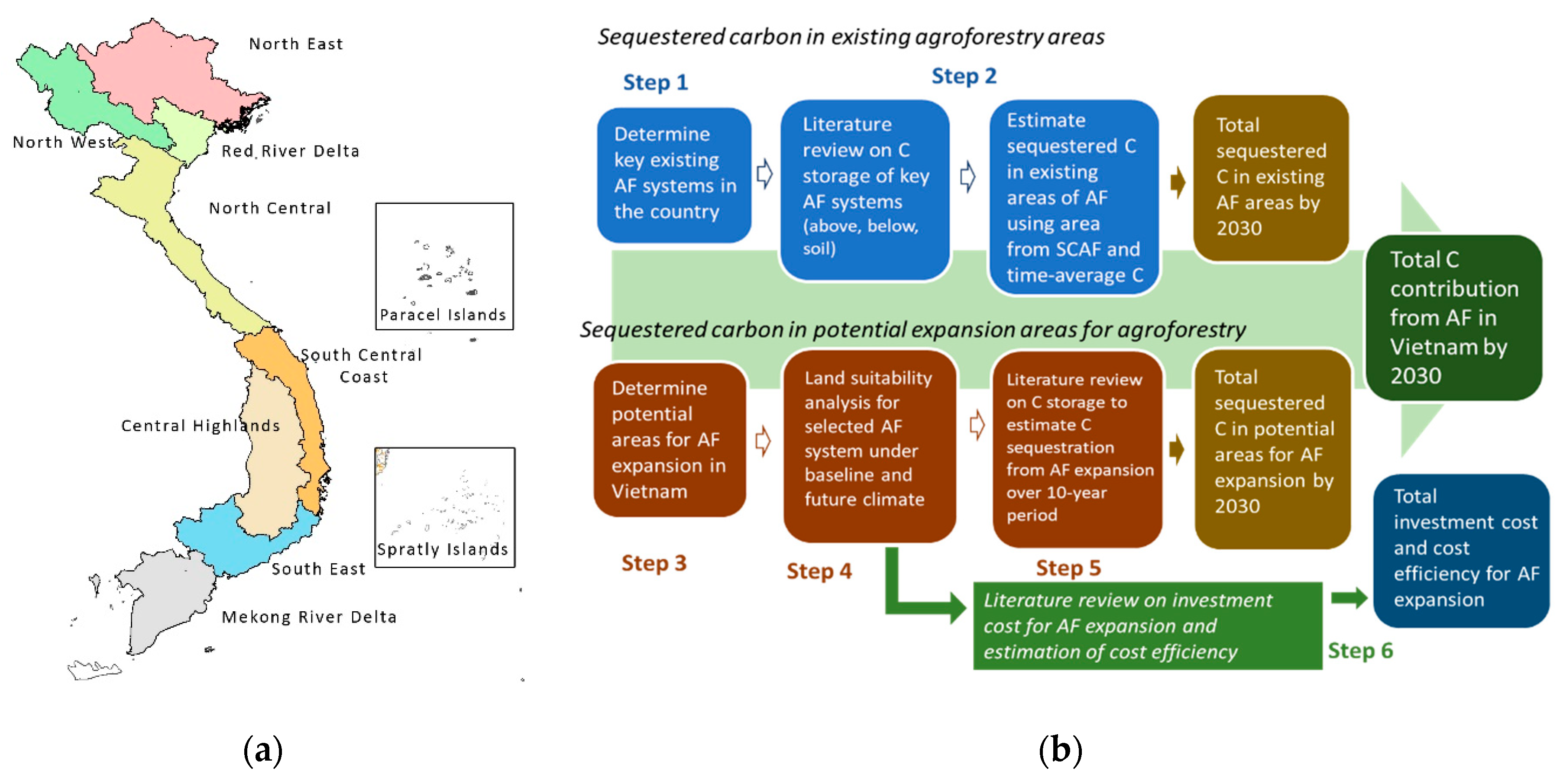
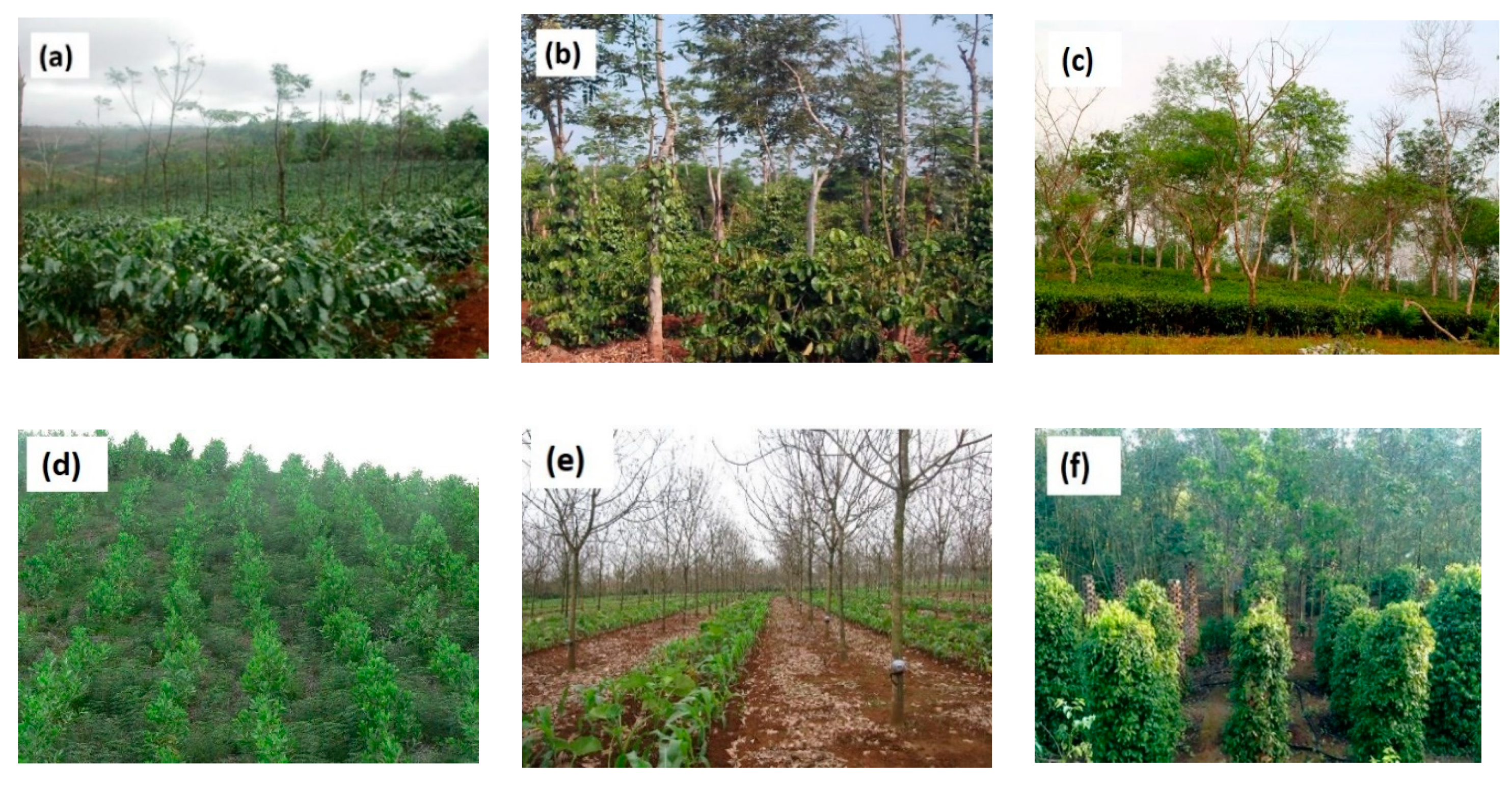
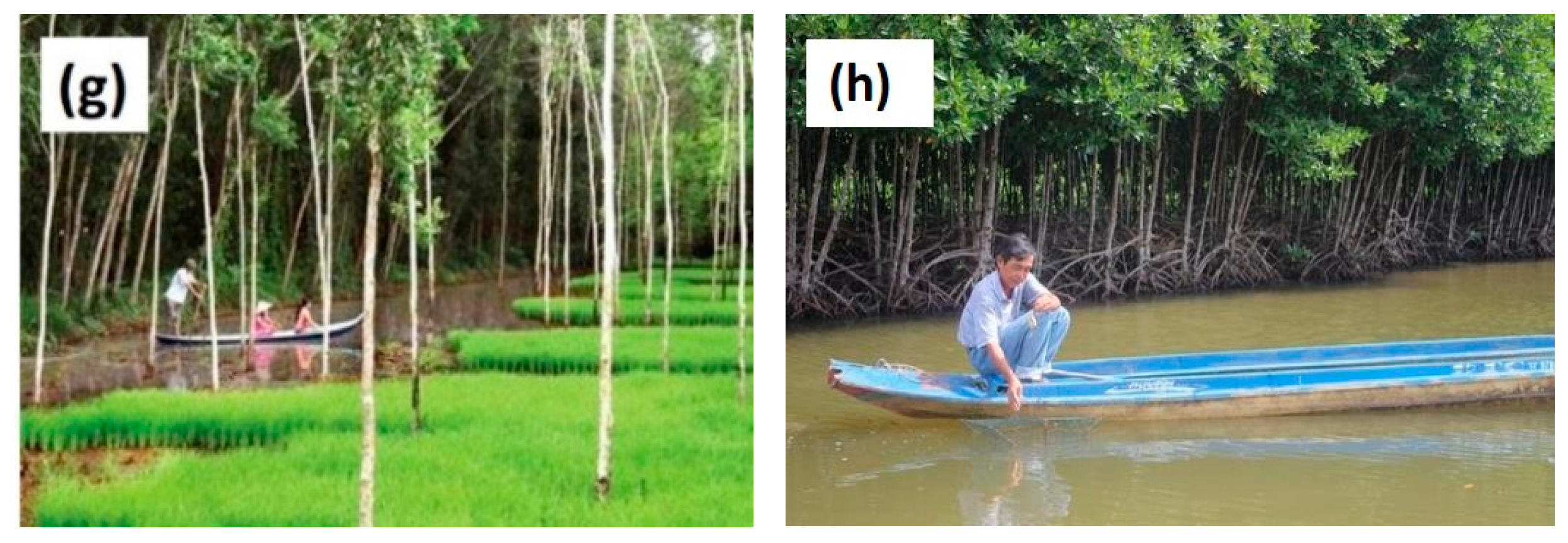
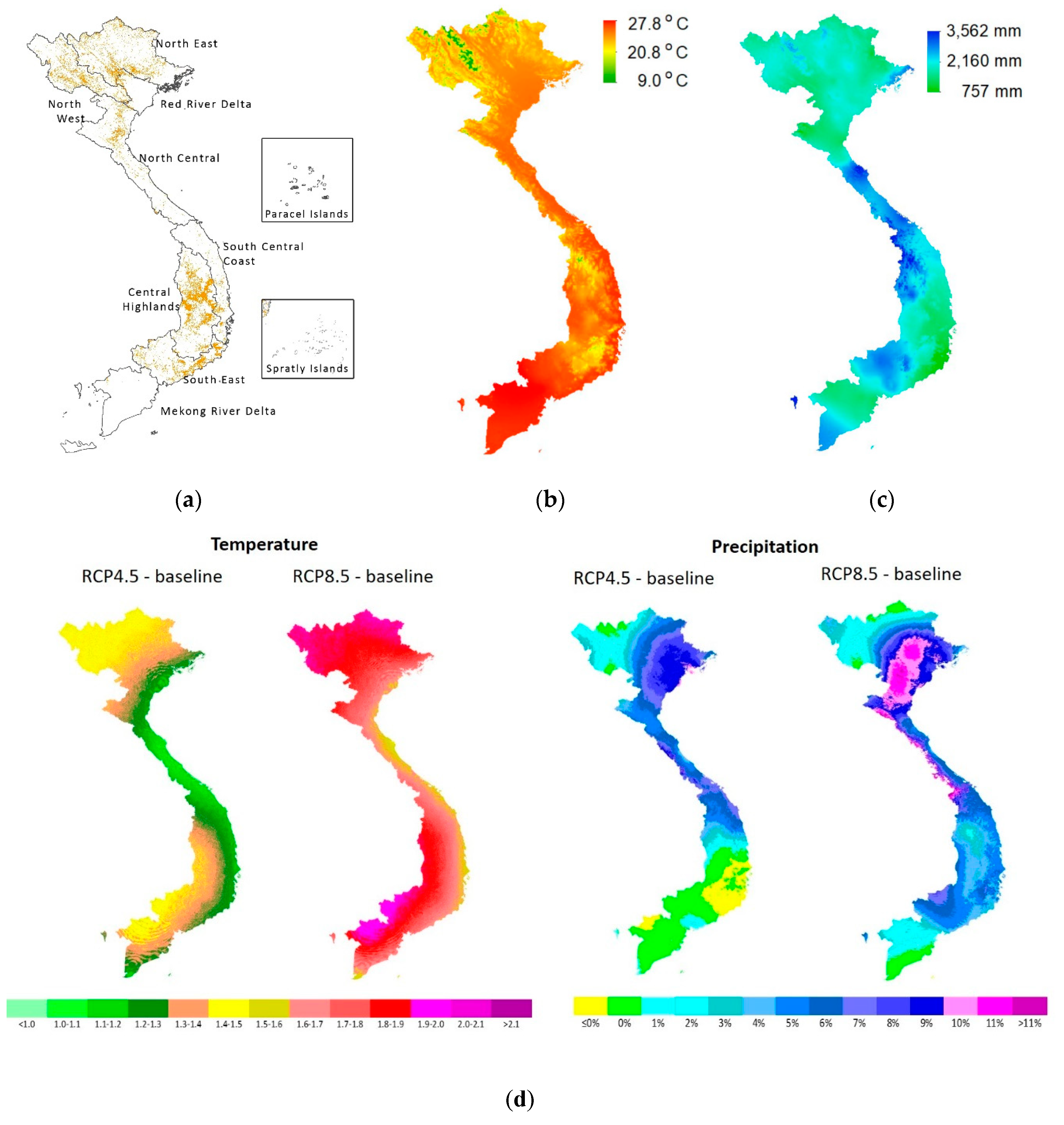

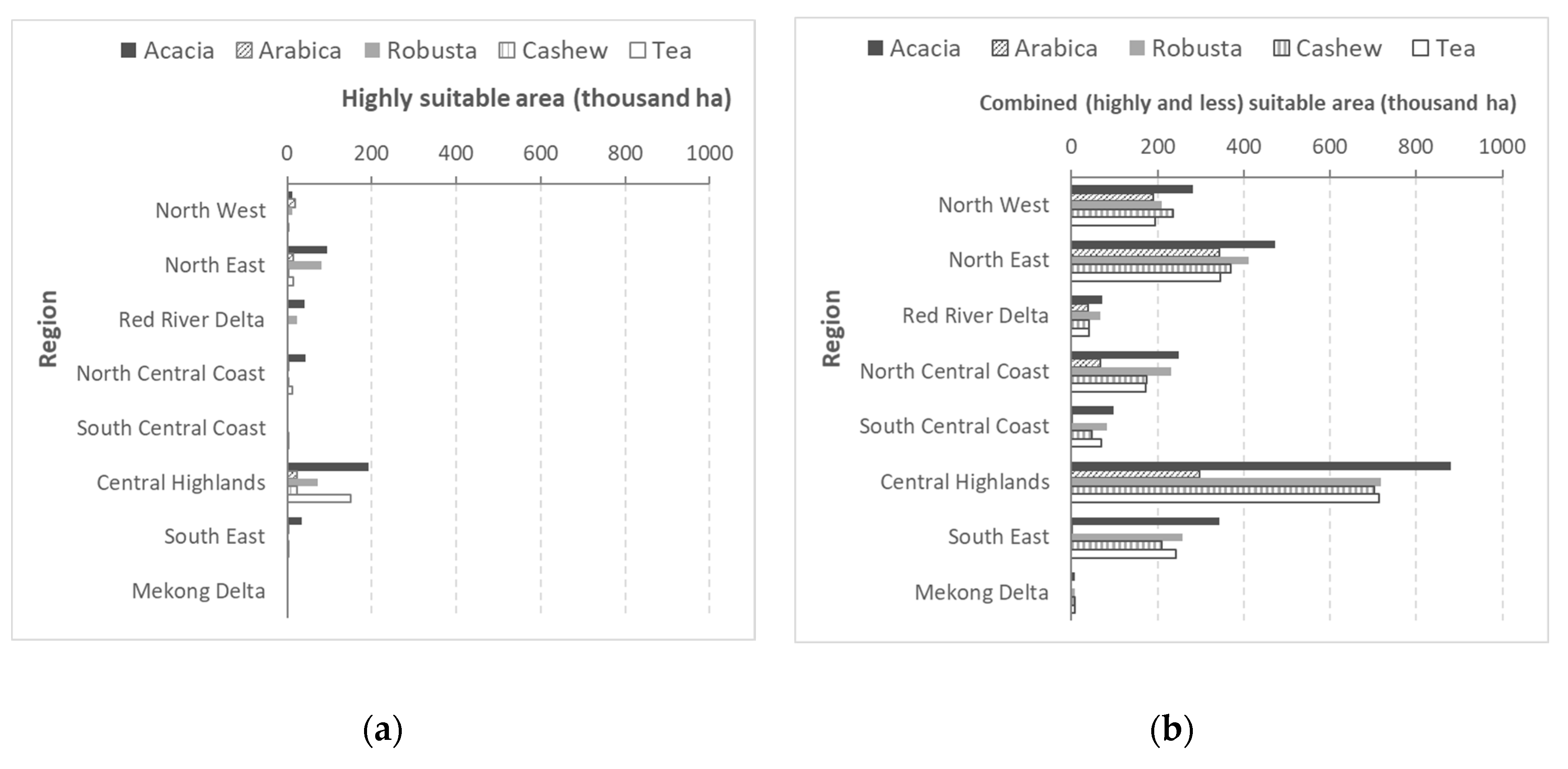
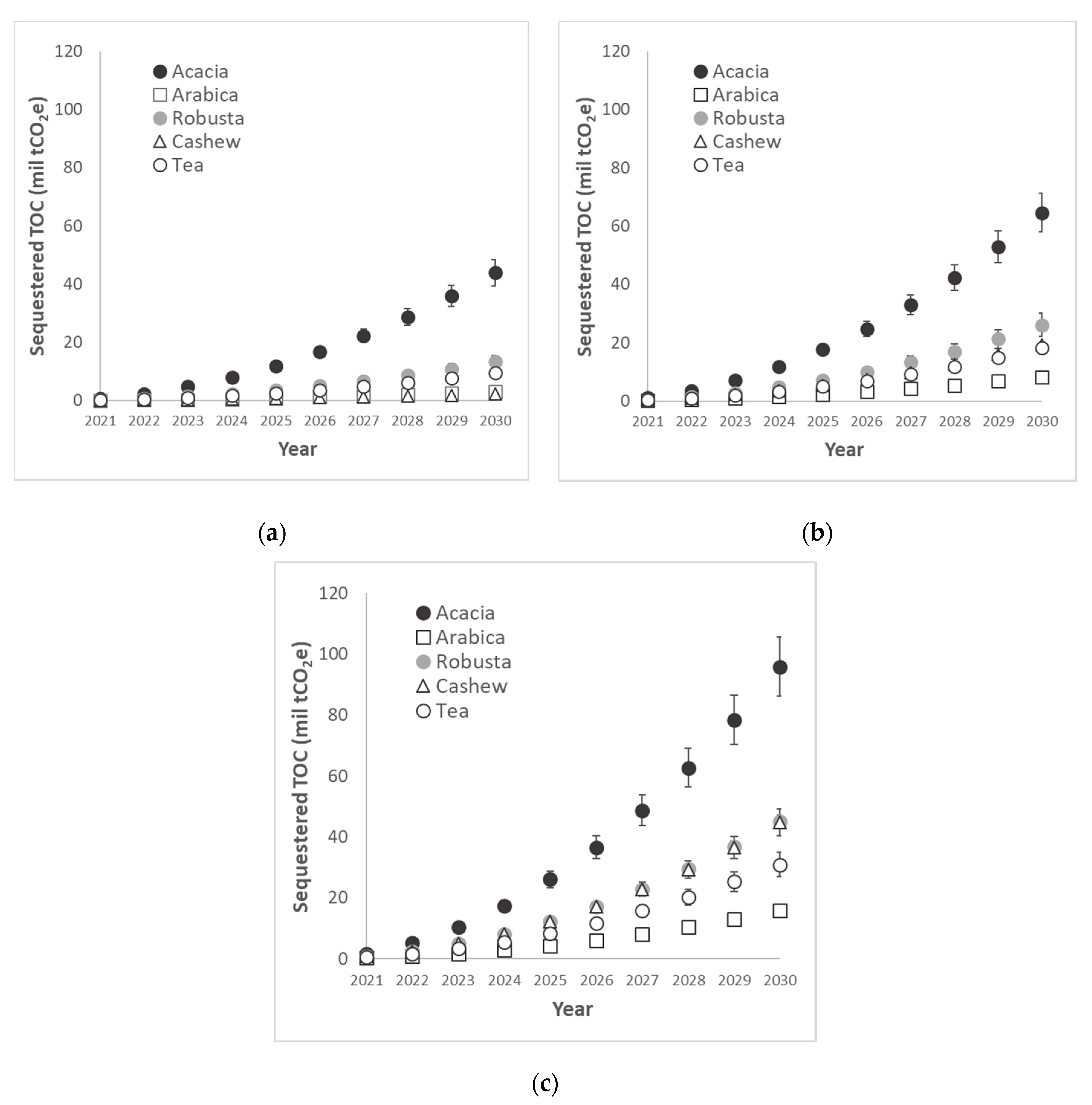
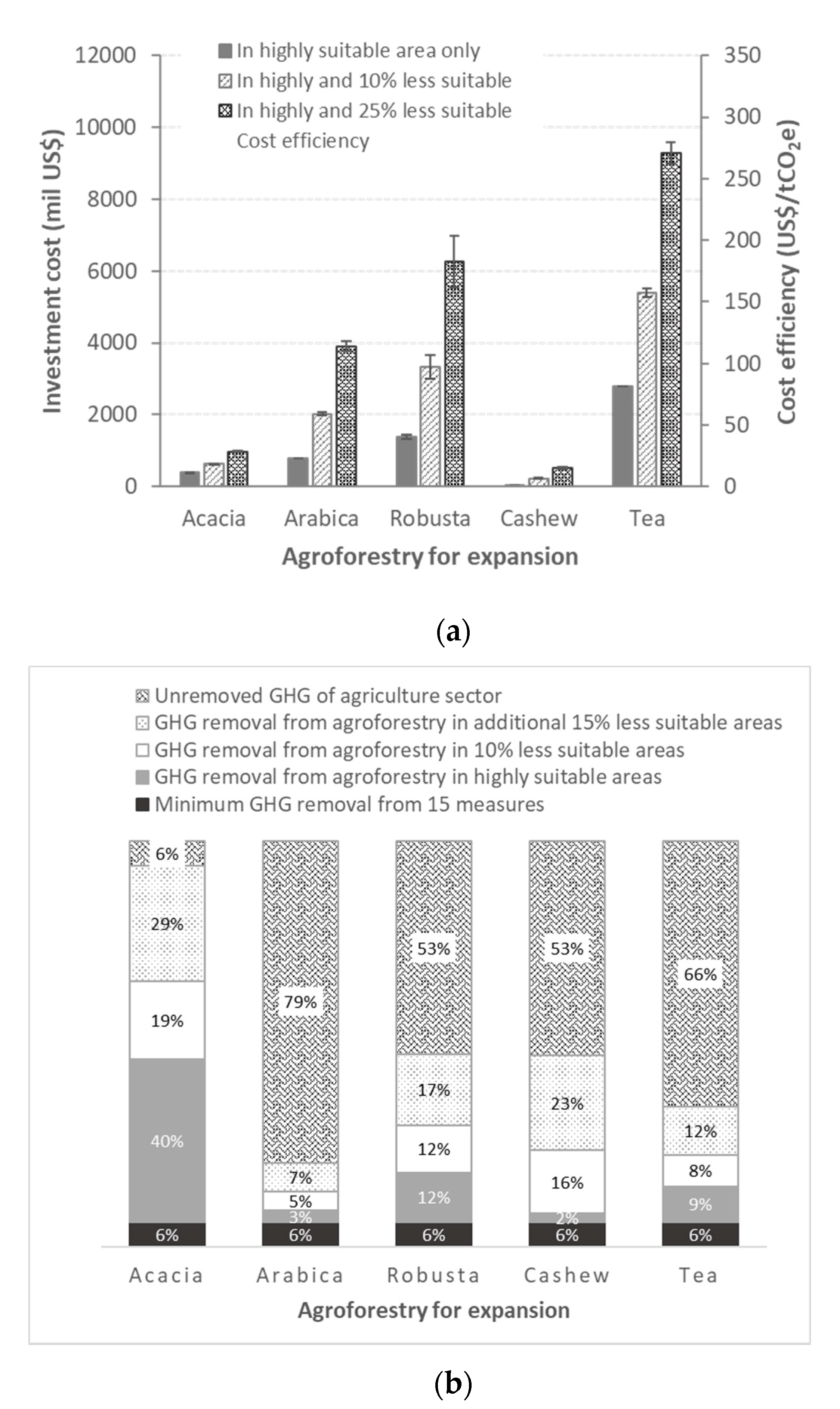
| Agroforestry System * | Total Area (103 ha) ** | Common System Components | Main Regions |
|---|---|---|---|
| Melaleuca (Melaleuca cajuputi)-based | 245.5 | Fresh-water inland forest with paddy rice, sugarcane, bananas, and fish | Mekong River Delta |
| Robusta coffee (Coffea canephora)-based | 245.3 | Cassia siamea, black pepper, fruit trees such as durian and avocado, and nuts such as macadamia | Central Highlands, South East |
| Rhizophora (Rhizophora spp.)-based | 149 | Mangrove system with shrimp farming | Mekong River Delta |
| Acacia-based | 129.5 | Acacia mangium, Acacia auriculiformis, or hybrid (Acacia mangium × Acacia auriculiformis), intercropped with cassava in the early years after tree planting until acacia canopy is closed | North East, Red River Delta, South Central Coast, Mekong River Delta |
| Rubber (Hevea brasiliensis)-based | 20.5 | Usually intercropped with cassava or maize in the early years after tree planting until rubber canopy is closed | North West, North Central Coast, Central Highlands |
| Arabica coffee (Coffea arabica)-based | 10.5 | Leucaena leucocephala, longan (Dimocarpus longan), mango (Mangifera indica), plum (Prunus salicina) as shade trees | North West |
| Cashew (Anacardium occidentale)-based | 10.4 | Intercropped with maize, black pepper, or Robusta coffee | Central Highlands, South East |
| Tea (Camellia sinensis)-based | 9.5 | Acacia mangium or hybrid, Cassia siamea, or Illicum verum as shade trees | North East, North Central Coast |
| Other systems | 79.8 | Various fruit- or timber tree-based systems with relatively small areas | Spread across regions |
| Acacia * | Cashew | Robusta | Arabica | Tea | |
|---|---|---|---|---|---|
| Reference | [20,21] | NIAPP ** (data unpublished) | NIAPP (data unpublished) | NIAPP (data unpublished) | [19] |
| s2 | |||||
| Soil type *** | Ac, Fl, RhFe, Gl | RhFe, Fe, Ac | RhFe, XaFe, Fe, Ac | RhFe, Fe | RhFe, Fe |
| Soil depth (m) | >1 | >1 | >1 | >1 | >1 |
| Slope (°) | <8 | <8 | <8 | <8 | <8 |
| Annual rainfall (mm) | 1500–2500 | 2100–2500 | 1600–2000 | 1000–2000 | >1800 |
| Annual temperature (°C) | 23–26 | 22–25 | 22–24 | 18–22 | >22–25 |
| s1 | |||||
| Soil type | Lu, Fe | Ac | Ac, Fl | Ac | Ac, HuFe |
| Soil depth (m) | 0.5–1 | 0.5–1 | 0.5–1 | 0.5–1 | 0.5–1 |
| Slope (°) | 8 to 35 | 8–<25 | 8–20 | 8–20 | 8 to 20 |
| Annual rainfall (mm) | 800–<1500; >2500–3500 | 1300–<2100; >2500 | 1200–1600; >2000 | 800–1000; >2000 | 1000–1800 |
| Annual temperature (°C) | 20–<23; >26 | 18–<22; >25 | –8–22, >24 | 14–<18; >22–24 | 15–22; >25–35 |
| s0 | |||||
| Soil type | Others | Others | Others | Others | Others |
| Soil depth (m) | <0.5 | <0.5 | <0.5 | <0.5 | <0.5 |
| Slope (°) | >35 | >=25 | >20 | >20 | >20 |
| Annual rainfall (mm) | <800; >3500 | <1300 | <1200 | <800 | <1000 |
| Annual temperature (°C) | <20 | <18 | <18 | <14; >24 | <15; >35 |
| Input Maps | Resolution | Coordinate System | Date | Source |
|---|---|---|---|---|
| Land cover | 1 arc second | Lat/Long World Geodetic System (WGS) 84 | 2018 | [15] |
| Digital Elevation Model (DEM) | 1 arc second | Lat/Long WGS 84 | 2019 | Advanced Land Observing Satellite (ALOS) Global Digital Surface Model (AW3D30) version 2.2 |
| Slope | 1 arc second | Lat/Long WGS 84 | 2019 | Generated from DEM |
| Soil type | 1: 1,000,000 | WGS 84 UTM Zone 48N | 2010 | NIAPP |
| Soil depth | 1: 1,000,000 | WGS 84 UTM Zone 48N | 2010 | NIAPP |
| Baseline average annual precipitation and temperature | 30 arc seconds | Lat/Long WGS 84 | 1960–1990 | WorldClim 1.4 |
| Future average annual precipitation and temperature | 30 arc seconds | Lat/Long WGS 84 | 2041–2060 | WorldClim 1.4 |
| System | Investment Cost (USD ha−1 year−1) | Source |
|---|---|---|
| Acacia agroforestry | 173 ± 4.6 | [26] for the case of South Central Coast |
| Arabica agroforestry | 2587 | SCAF database for the case of North West |
| Cashew agroforestry | 213 | SCAF database for the case of South East |
| Robusta agroforestry | 2124 ± 574 | SCAF for the case of Central Highlands |
| Tea agroforestry | 2806 | SCAF database for the case of North East |
| Arabica sole plantation | 1835 | [27] for the case of North Central Coast |
| Robusta sole plantation | 941 ± 24 | [28] for the case of Central Highlands |
| Tea sole plantation | 2642 | [29] for the case of Central Highlands |
| Acacia | Arabica | Robusta | Cashew | Tea | |
|---|---|---|---|---|---|
| Highly suitable (thousand ha) | |||||
| Baseline | 419 | 54 | 189 | 24 | 181 |
| RCP 4.5 | 435 | 15 | 36 | 21 | 170 |
| RCP 8.5 | 389 | 6 | 32 | 17 | 127 |
| Combined (highly and less) suitable (thousand ha) | |||||
| Baseline | 2407 | 937 | 1985 | 1789 | 1787 |
| RCP 4.5 | 2447 | 362 | 1980 | 1761 | 1784 |
| RCP 8.5 | 2468 | 268 | 1997 | 1827 | 1797 |
| Impact of climate change on highly suitable area (%) | |||||
| RCP 4.5 | 4% | −72% | −81% | −14% | −6% |
| RCP 8.5 | −7% | −89% | −83% | −32% | −30% |
Publisher’s Note: MDPI stays neutral with regard to jurisdictional claims in published maps and institutional affiliations. |
© 2020 by the authors. Licensee MDPI, Basel, Switzerland. This article is an open access article distributed under the terms and conditions of the Creative Commons Attribution (CC BY) license (http://creativecommons.org/licenses/by/4.0/).
Share and Cite
Mulia, R.; Nguyen, D.D.; Nguyen, M.P.; Steward, P.; Pham, V.T.; Le, H.A.; Rosenstock, T.; Simelton, E. Enhancing Vietnam’s Nationally Determined Contribution with Mitigation Targets for Agroforestry: A Technical and Economic Estimate. Land 2020, 9, 528. https://doi.org/10.3390/land9120528
Mulia R, Nguyen DD, Nguyen MP, Steward P, Pham VT, Le HA, Rosenstock T, Simelton E. Enhancing Vietnam’s Nationally Determined Contribution with Mitigation Targets for Agroforestry: A Technical and Economic Estimate. Land. 2020; 9(12):528. https://doi.org/10.3390/land9120528
Chicago/Turabian StyleMulia, Rachmat, Duong Dinh Nguyen, Mai Phuong Nguyen, Peter Steward, Van Thanh Pham, Hoang Anh Le, Todd Rosenstock, and Elisabeth Simelton. 2020. "Enhancing Vietnam’s Nationally Determined Contribution with Mitigation Targets for Agroforestry: A Technical and Economic Estimate" Land 9, no. 12: 528. https://doi.org/10.3390/land9120528
APA StyleMulia, R., Nguyen, D. D., Nguyen, M. P., Steward, P., Pham, V. T., Le, H. A., Rosenstock, T., & Simelton, E. (2020). Enhancing Vietnam’s Nationally Determined Contribution with Mitigation Targets for Agroforestry: A Technical and Economic Estimate. Land, 9(12), 528. https://doi.org/10.3390/land9120528





